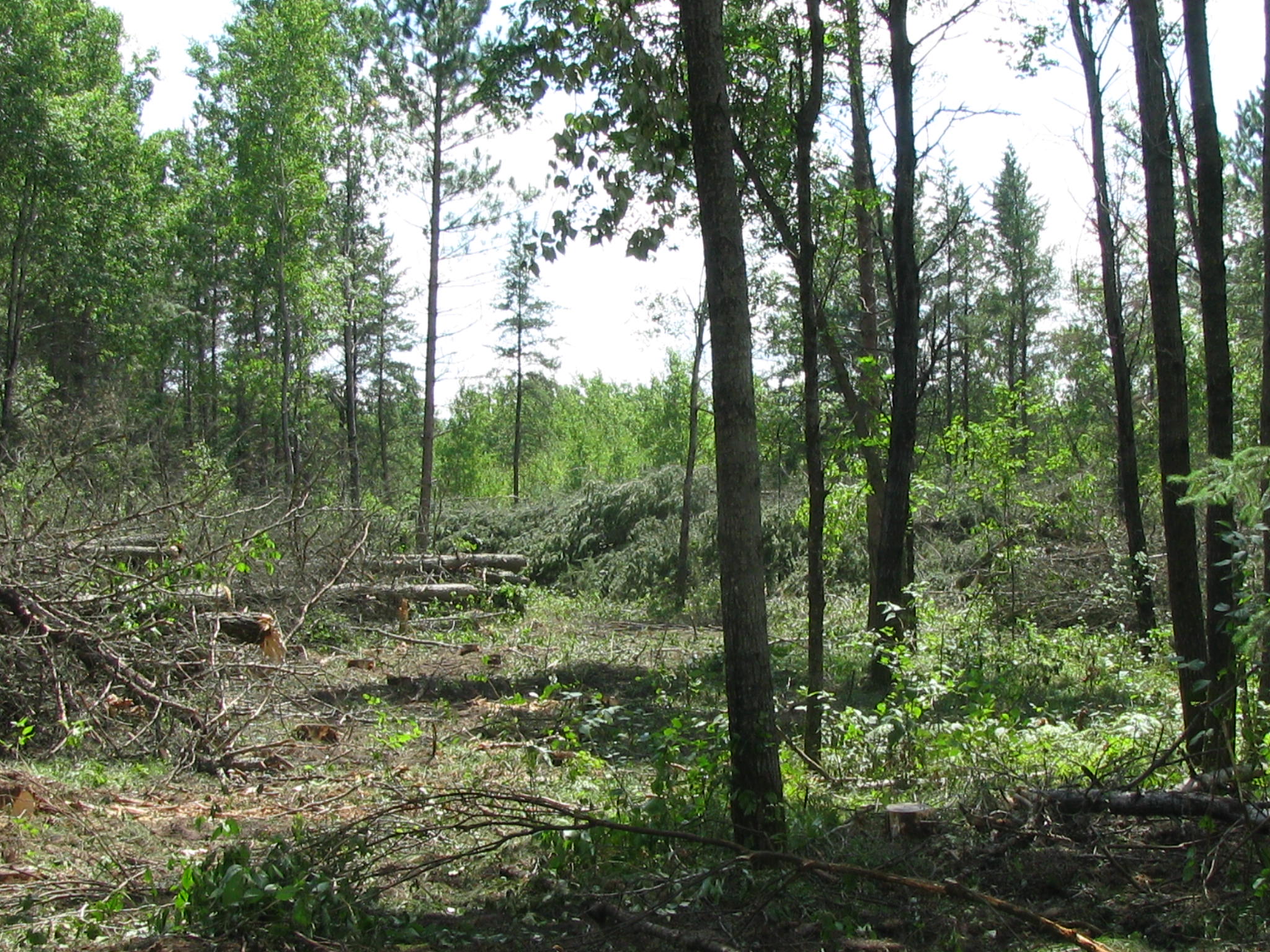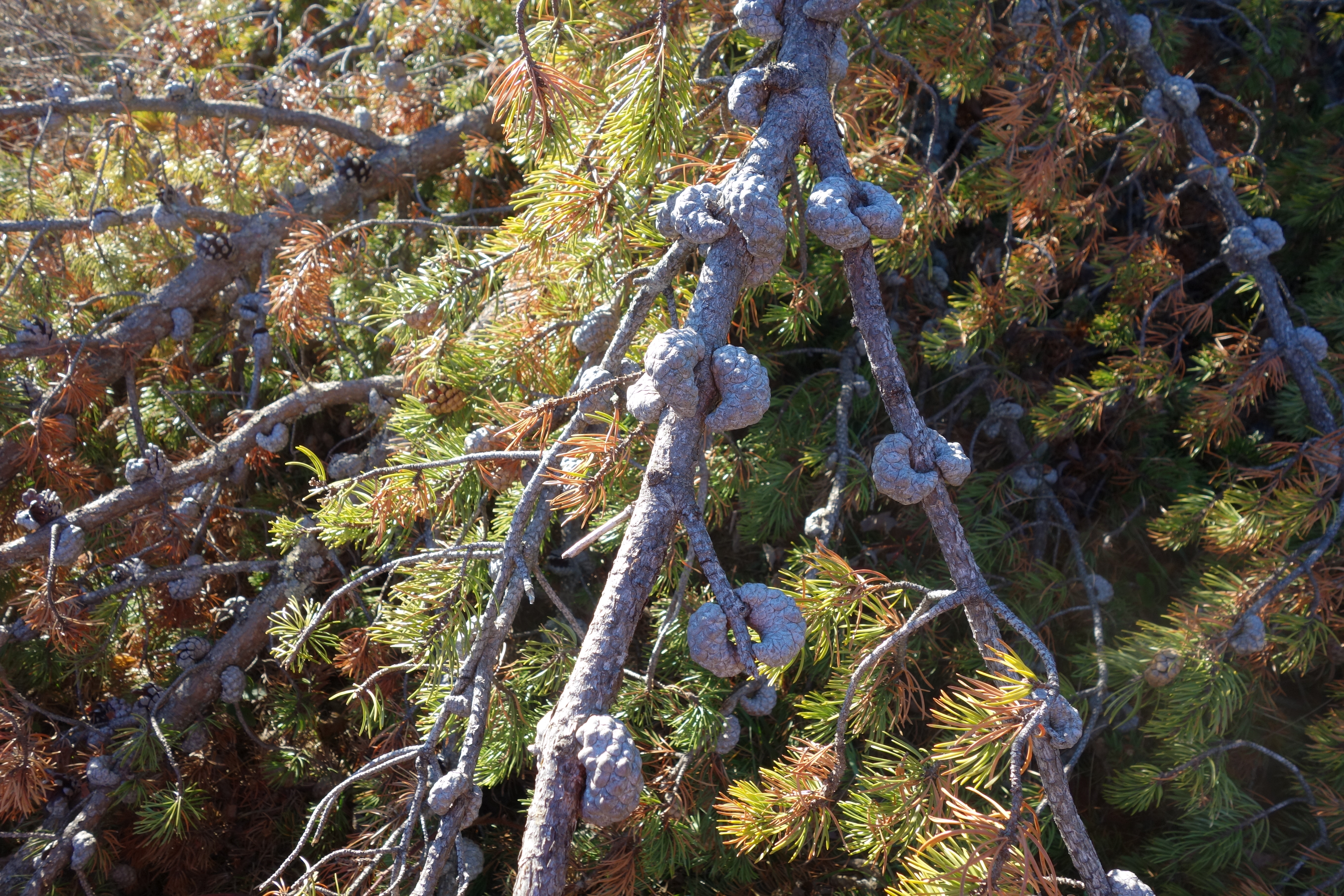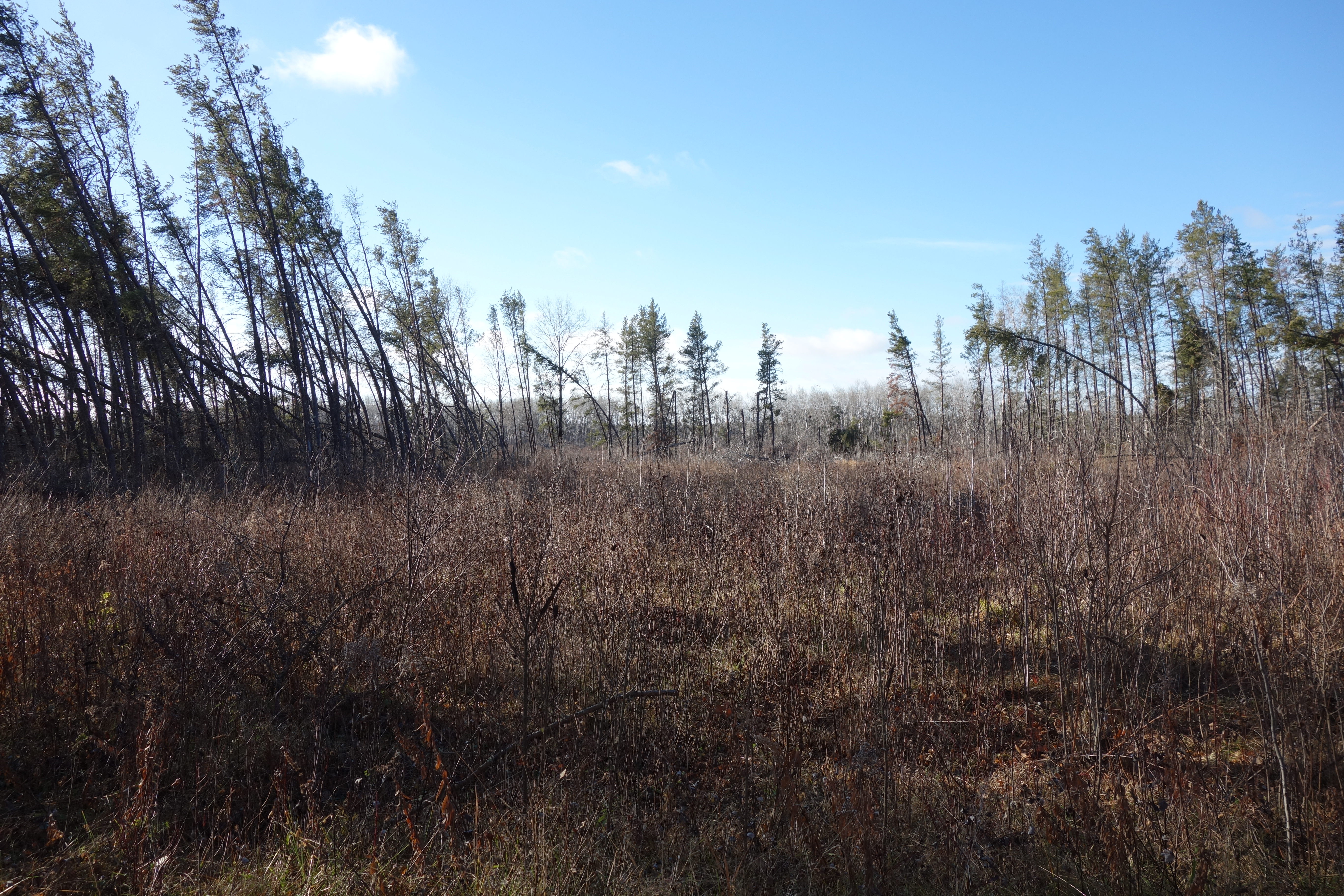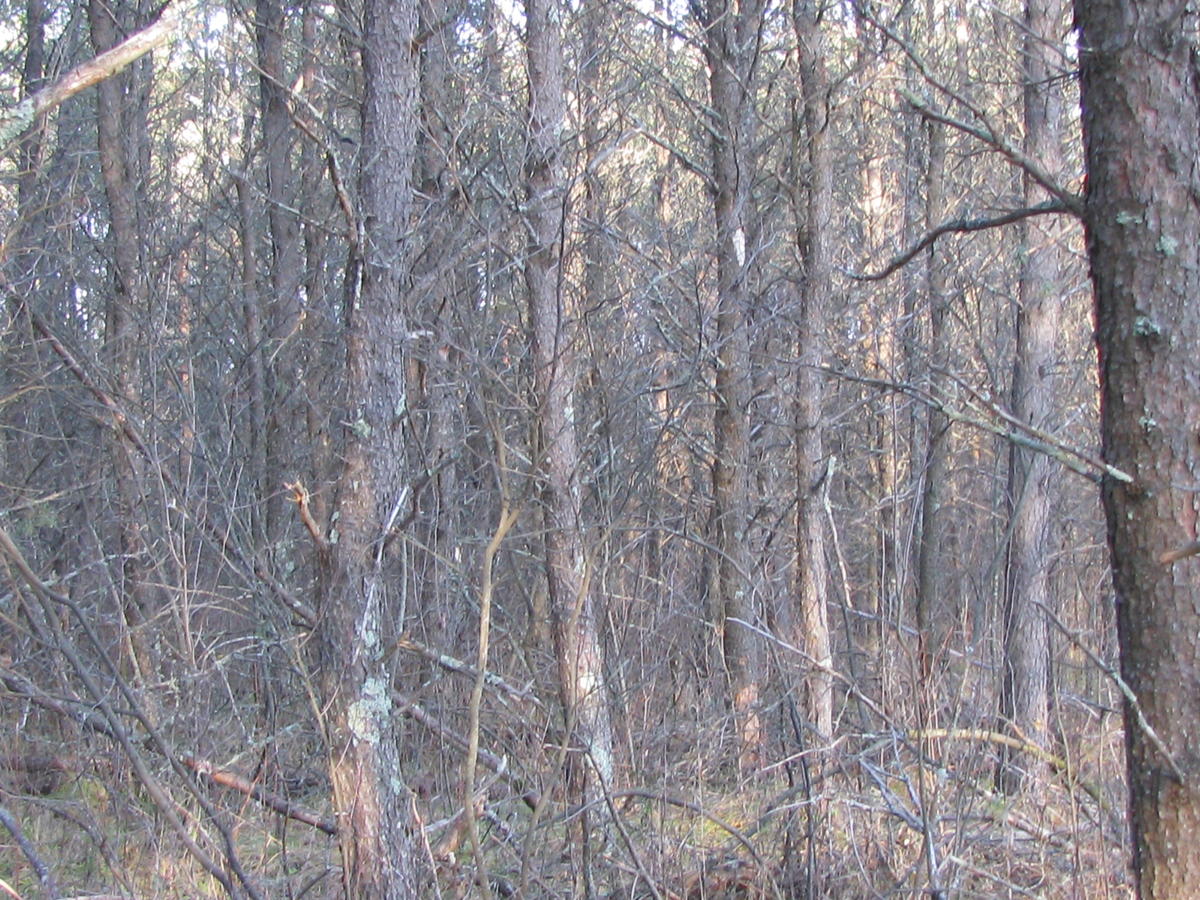Overview

Figure 1: Jack pine strip clearcut.
This was an attempt to improve our success with natural jack pine regeneration in Central Rich Dry Pine Woodlands (FDc24) by maintaining a live onsite seed source. It was one of six sites chosen for an Adaptive Forest Management Project, intended to demonstrate creative solutions to persistant problems. Regenerating jack pine in the central floristic region has been problematic because documented silviculture methods are suited to the northern floristic region and foresters were slow to recognize that two distinct races of jack pine exist in Minnesota. The race of jack pine indigenous to the central region is short-lived, has thick bark to withstand ground fire, and has a high ratio of semi-serotinous cones. It is adapted to frequent ground fire and open woodland growing conditions. Central jack pines lack the stores of viable seed that is typical in northern stands because their cones open whenever the air temperature exceeds 80 degrees. Central Rich Dry Pine Woodlands, such as this site, tend to be very brushy because they have higher fertility than most fire dependent communities in Minnesota. They are subject to frequent drought, confounding efforts to regenerate them with a single treatment.
Silviculture Objective(s)
- Obtain 300 jack pine seedlings per acre with a 50% stocking level within five years.
- Maintain a robust native plant community through avoidance of chemicals
Pre-treatment stand description and condition
Stand establishment and management history:
A 1939 aerial photo shows these sites to be in a woodland condition with >75% canopy cover. The area burned in 1949. A 1953 aerial photo shows the north block to be open and furrowed. The south block appears partially vegetated, probably with shrubs. Our records show that the north block was roller-chopped in 1964, aerial sprayed with 2,4-D and 2,4,5-T in early August, 1965, furrowed with a Hester plow in 1967, and hand-planted with jack pine seedlings after two days of rain in May, 1968. I couldn’t find records on the south block. I assume it was treated in a similar fashion.
Pre-treatment species composition:
Jack pine (Pinus banksiana) was the dominant species at the start of this project in 2009. A minor component of quaking aspen (Populus tremuloides) is present and was reserved from harvest to discourage its regeneration by root sprouts. The understory contained bur oak, black cherry, balsam fir, American elm, and quaking aspen. Dominant shrubs were beaked hazel, American hazel, chokecherry, red raspberry and gray dogwood.
Pre-treatment growth and stocking:
The timber sale contained 180 cords of jack pine with diameters ranging from 8 to 11".
Pre-treatment forest health issues:
Some jack pine mortality, probably stemming from damage by the jack pine budworm (Choristoneura pinus Freeman), was causing a thinning of the canopy. Shrub density was moderate to high.
Landowner objectives/situation:
Lead efforts to demonstrate how silvicultural tools can provide a sustainable supply of timber. Monitor results of management actions. Use demonstration projects to test and evaluate creative approaches.
Regenerate jack pine using a two-entry harvest. The first harvest would remove jack pines from two-chain-wide strips. Reserve seed trees in one-chain-wide reserve strips. Following regeneration of the harvested strips, the reserve strips would be logged.
Silviculture Prescription
Target regeneration: 300+ fairly well distributed jack pines/acre in the cut strips
Residual stand would contain 1-chain wide reserve strips with abundant jack pine seed trees and perhaps some aspen. The cut strips may have some residual aspens, but otherwise no mature trees.
Harvest was specified as the frost-free season, in order to achieve some soil scarification. Full-tree skid and either burn the slash or sell it for biomass to reduce the nutrients on the site.
Timber harvest guidelines would conform to the Minnesota Site Level Guidelines. Residual trees after the final harvest would partly be aspens in the strips cut in the first entry and partly mixed species in strips cut in the final entry. Residual trees after the final harvest would include aspens, red pines and perhaps some scattered jack pines. Strips cut in the final entry would gradually regenerate from seed dispersed during logging and from seed produced by early-regenerated jack pines.

Figure 2: Curved jack pine cones on a fallen tree on the project site
What actually happened during the treatment
The designated strips were harvested in August and September, 2012. A feller buncher and grapple skidder were used. Slash was piled and burned.

Figure 3: Harvest strip and wind-damaged reserve strip
Regeneration failed. In November, 2016, we found an average of 47 jack pine seedlings/acre and 2000 aspen saplings/acre. A windstorm in the summer of 2016 toppled 40-60% of the jack pines in the reserve strips. Every downed tree on the site had curved cones, suggesting they came from northern jack pine seed. Kentucky bluegrass is very abundant. Shrub density is not as high as expected. Red raspberry (Rubus idaeus, a seedbank species) was the most abundant shrub.
Post-treatment assessment
A species/area plot was installed on 7/3/2010, prior to treatment, and remeasured on 9/11/2013, after harvest. Its purpose was to measure species richness, responding to the secondary goal of maintaining elements of the native plant community. We tallied 77 species in the pre-treatment measurement and 96 species in the post-treatment measurement.
Twenty-five species identified in the pre-treatment visit were not found on the plot afterward. However, some were present in other locations within the project area. One of those (Kentucky bluegrass /Poa pratensis), is non-native and, although it wasn’t found on the plot after harvest, it has since run rampant throughout the project area. Four species were native grasses. Six were native shrubs. One (balsam fir /Abies balsamea) was a native tree species that invades Fire Dependent Native Plant Communities that are deprived of their natural disturbances for extended periods.
Forty-five new species were found in the post-treatment visit. Ten were non-native species. Five were native grasses. Two were native shrubs. The others were native forbs and ferns.
A species turnover of 57% is extraordinary. Could no tree cover, and the agricultural mechanical and chemical treatments that took place over a span of 19 years prior to establishment of jack pine in the 1960s show such profound effects, 45 years later? Certainly, the presence of non-native species in the access road prior to harvest also affected the post-treatment species composition.
Jack pine stocking in the reserve strips may have been adequate for seed production and dispersal, except that a high percentage of the cones were likely serotinous, something we didn’t realize until late in the project.
An east-west orientation of strips may be a better plan if we had indeed been dealing with semi-serotinous cones. Prevailing winds are more likely to be southerly during the warm seed dispersal days. Jack pine seedlings seem to survive more readily with a little shade which would have been more available along the south edge of strips running east/west.
Kentucky bluegrass (Poa pratensis) was abundant in the access road and nominally present within the stands prior to harvest. After harvest, it quickly colonized and proliferated throughout the stands. It is a formidable competitor for soil moisture. Its rooting zone is within 5” of the surface, competing directly with tree seedlings. Its primary growth period is spring, the same as for jack pine. Jack pine easily invades native deep-rooted grasses like big bluestem (Andropogon gerardii), but cannot compete with Kentucky bluegrass on droughty sites.
The adaptive management project team dropped the ball on coordinating follow-up treatments. Trying to convene five busy people to make assessments and prescriptions was challenging. We should have anticipated needs and scheduled them early in the project with the idea that they could be cancelled if they were determined to be unnecessary.
Herbivory by white-tailed deer could have been a factor. It is common in the area, but we saw no evidence of it.
A wind storm during the summer of 2016 laid down 40-60% of the reserved seed trees and exposed the remaining trees to increased risk.
Plans for future treatments
The extent of broken and toppled trees has reduced the chances of getting sufficient seed to regenerate the site. The knowledge that the cones are curved, so are likely from a northern provinance, and are likely serotinous, is further discouragement from proceeding with contingency plans to control competing vegetation and rehabilitate the seedbed in hopes of natural regeneration. The remaining trees are being salvaged from the reserve strips and the site is going to be site prepped and planted.
Costs and economic considerations
Planning took more time than a typical harvest and regeneration project because it was part of an adaptive management project. A team of two foresters, a wildlife manager, an ecologist and a forest health specialist met several times. Marking and cruising took two days.
The appraised volume of the timber to be harvested was 180 cords, with a value of $1627.20. Annual regeneration surveys from 2013 to 2016 took one person day for each visit. Species/area plot measurements took one person-day per visit.
Other notes
December 2018 update: Monitoring on two additional Central Rich Dry Pine Woodland sites has been terminated for this project. The Welsh Lake State Forest site, in Section 28-Twp 144- Rge 31, showed 1363 jack pine seedlings and 73% stocking after one growing season following the strip harvest. After five years, the site had 1357 jack pines and 250 red pines per acre and 50% stocking. The survey indicated that release from shrub competition was needed. After seven growing seasons and no release, we counted 176 jack pines and 100 red pines per acre and 46% stocking. After eight growing seasons and no release, we found less than 100 jack, red, and white pines per acre. Shrubs are very dense. Reserve strips still contain enough seed trees for regenerating the site. We are contemplating next steps.
The Oshawa site (Sec 36- Twp 138- Rge 32) held 2000 jack pines per acre with 47% stocking after three growing seasons. Stocking seemed strongly correlated to the abundance of jack pines in the reserve strips. Some strips were dominated by aspens and oaks with very few jack pines. Release from competing shrubs was advised but didn't happen. Seven years after the initial harvest, no pine seedlings are evident on the site.
These trials confirm that natural regeneration in this very brushy Native Plant Community is possible if the initial strip harvest occurs before the canopy begins to thin and seed trees with non-serotinous cones are reserved during harvest, but vegetative release from competitive shrubs and hardwood trees in mandatory, likely by age three.
Summary / lessons learned / additional thoughts
Make solid contingency plans early in the life of a project when managing by committee. Cancel them later, if deemed unnecessary.
Carefully determine whether cones are serotinous or not, and design the project accordingly. According to Dr. Carrie Pike (US Forest Service and Purdue University), the serotiny gene is carried in pollen. Therefore, even jack pines native to the Central Floristic Region can produce a high ratio of serotinous cones if they receive pollen from northern jack pines that have been planted nearby. A live persistent seed source seems essential when managing jack pine with semi-serotinous cones and expecting natural regeneration, but is not particularly effective when jack pines have serotinous cones (unless fire is used to open the cones).
Study the site history. If regenerating the site was a struggle in the past, it's probably naive to expect it to be easier, this time. The historic use of chemicals and other extraordinary measures may have added complications to current efforts. Historic weed presence can result in a seed bank that will respond to disturbance. Several weed species found on this site can establish seed banks with longevity in excess of 20 years, and common mullien (Verbascum thapsus) seeds can remain viable for 100.
Short rotations make sense for jack pine in this native plant community. When we first visited this site, the trees were 42 years old and already were experiencing significant mortality, with a corresponding increase in shrub density. Foresters are pressured by other natural resource professionals to avoid herbicide use, but also to delay harvest. In a native plant community like this, that typically has a very robust shrub layer, delaying harvest much past age 40 will greatly increase the risk that we cannot regenerate jack pine without herbicide or very intensive use of fire.
Supplemental content ("appendices")
![]() Download central_vs_northern_fd_map.jpg (383.14 KB)
Download central_vs_northern_fd_map.jpg (383.14 KB)
![]() Download spac_fdc24-0002_roy_lake_rs1.pdf (106.03 KB)
Download spac_fdc24-0002_roy_lake_rs1.pdf (106.03 KB)
![]() Download spac_fdc24-0002_roy_lake_sa1.pdf (104.18 KB)
Download spac_fdc24-0002_roy_lake_sa1.pdf (104.18 KB)
![]() Download spac_comparison_report.pdf (16.38 KB)
Download spac_comparison_report.pdf (16.38 KB)
![]() Download 2016_regen_survey.pdf (308.56 KB)
Download 2016_regen_survey.pdf (308.56 KB)
Submitted by
Harvey Tjader
Harvey was a staff forester at the MNDNR Northwest Region headquarters in Bemidji, MN. His primary focus was Ecological Land Classification and applications in silviculture. Prior to 2008, he was primarily involved in the timber program. He worked for the Minnesota DNR since he graduated from the University of Minnesota in 1978. Harvey passed away in July of 2022.
